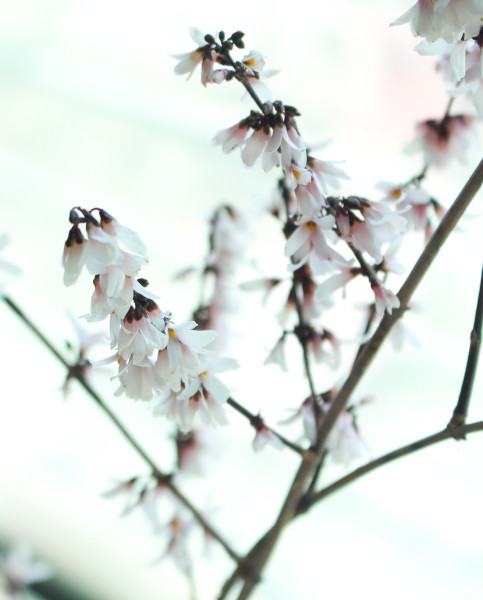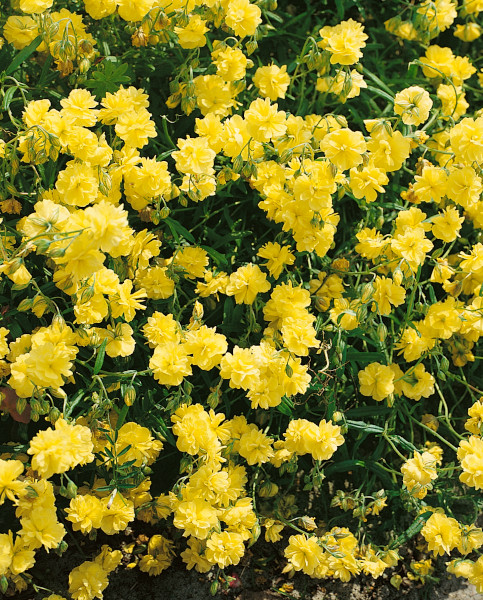How to grow Abeliophyllum
‘Abeliophyllum is a relatively open, deciduous shrub or small tree. Commonly known as White Forsythia, this Korean native’s ovate, dark green leaves turn deep purple before falling in autumn. Between late winter and spring, racemes of highly fragrant, white or pink flowers appear before the new foliage emerges. In maturity, this shrub will reach a maximum height and spread of 1.5m x 1.5m.

Key Information
Soil pH
Position
Hardiness


Where & when to plant abeliophyllum
‘Abeliophyllum can be planted all year-round, as long as the ground is not waterlogged or frozen. Choose an east or south facing location with moist, well-drained soil. Gardens with chalky, loamy or sandy soils are ideal. To avoid damage to flowers and young growth by late winter or early spring frosts, this shrub is best planted in a sheltered position. Suitable as a patio or container plant, ‘Abeliophyllum distichum’ can also be planted in flower borders and beds and is particularly attractive when trained against a wall.
How to plant Abeliophyllum
Give your plant a good water while it is still in its container.
Remove the shrub from the pot and gently tease out any matted roots.
Dig a planting hole the same depth and three times the width of the root mass.
With a fork, loosen any compacted soil on the base and sides of the hole.
Remove any excessive top layers of compost so that the roots are not too deeply planted.
Place the shrub in the hole and back fill it with soil, taking care to avoid leaving air pockets.
Firm the soil gently and water to help settle the earth around the shrub.
A mulch around the plant is a good idea, however, keep mulch 10cms away from the plant’s base to prevent rot.

What to plant with Abeliophyllum
Combine ‘Abeliophyllum distichum’ with other sun-loving plants. Choose plants which bloom after this shrub has finished flowering. Those with compact foliage will provide an interesting contrast. Alternatively, select evergreens to provide colour during late autumn and early winter. Plant larger evergreen shrubs behind your White Forsythia to show off the spring blooms and avoid limiting the amount of sunlight it receives.
If you would like any further planting ideas or growing advice for your ‘Abeliophyllum distichum’, please contact our friendly and knowledgeable Customer Care Team - we will be more than happy to help you.



How to care for Abeliophyllym
Pruning and Deadheading
Annual pruning encourages healthy new growth, extends the shrub’s life and improves flowering. Prune in early summer after flowering has finished once any risk of frost has passed. Newly planted shrubs - less than two years old - will only need lightly trimming and shaping.
If grown as a freestanding shrub, prune the stems of the established plant back by one-third, cutting above nodes. If required, the shrub can be hard pruned every 4 years to maintain the shape.
When White Forsythia is trained against a wall, firstly tie in new growth to fill gaps and remove dead shoots. Next, remove any remaining shoots growing in the direction of the wall and generally trim any remaining, overly long stems to within a few nodes of the permanent framework of branches.
Watering
Feed and water young plants until fully established. Feed and mulch after pruning.
Cold Protection
Abeliophyllum distichum is a hardy shrub, however to avoid frost damage on young plants, this shrub benefits from being planted in a sheltered position or grown against a wall for added warmth.
Pests and Diseases
Abeliophyllum distichum is generally pest and disease free.
How to propagate Abeliophyllym
1) Softwood Cuttings
Take softwood cuttings from the new growth in summer. Cutting just above a leaf node, snip off a young shoot approximately 5-10cms in length and place in a plastic bag with a little water to prevent wilting.
Pinch out the tip and remove lower leaves. Dip the lower end of each cutting in hormone rooting solution or powder.
Loosely fill small containers with multi-purpose compost. Tap the base of the tray or containers on a bench to settle the soil.
Using a stick or pencil make a hole for each cutting and plant them out, firming the cuttings into the compost gently. Water generously.
To reduce water loss, you can use a propagator or cover individual pots with a plastic bag.
Label your cuttings with both the plant name and date the cutting was taken, as these cuttings will not be ready to plant out until the following year.
Keep your cuttings in good light, though not direct light, and kept moist during the first month while rooting occurs.
Monitor root growth and pot on as and when required. Harden off gradually before planting out
2) Layering
Choose a healthy, low-growing shoot on the outer edges of the parent plant which will bend without breaking. Locate the point along this stem where it will easily reach the ground and remove any leaves on this portion of the shoot.
Select a leaf node in this section of the shoot. Using a knife, make a slanted cut through the node. The cut should go no deeper than half the width of the stem.
Apply hormone rooting solution or powder to the cut and use a matchstick to wedge the wound open slightly.
Mark the ground where the sliced part of the stem will easily meet it and dig a small trench in this location around 10-15cm deep. If the soil is poor, you can also mix some potting mix into the trench.
Plant the wounded part of the stem in the trench and, using a thick piece of bent wire, secure this section of the stem into the ground. Cover the planted section of stem with a small mound of soil or potting mix and firm the soil around the planting.
Drive a cane into the soil close by, then tie the free end of the stem to the cane, encouraging it to grow upwards.
Water your layer well, keeping it moist during the growing season.
Within 12 months roots should develop on your layer. In the following summer, cut the rooted stem from the parent plant and either pot it or transplant it to another location in your garden.
Common Abeliophyllum questions
What does White Forsythia smell like?
It has a honey-almond fragrance.
How fast does this shrub grow?
White forsythia is known to have a rapid growth.
What colour are the flower-buds?
Purplish buds.




